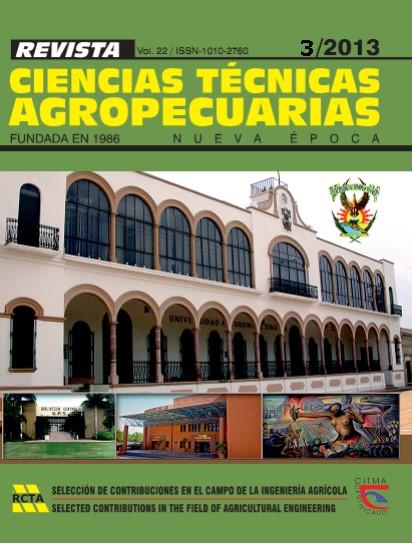Mathematics: a tool applicable to Agricultural Engineering
Main Article Content
Abstract
In this paper we show a group of real examples from various agricultural research, with the goal of exposing the use of mathematical tools applied to them. Also highlights the fundamental basic problems that arise in the agricultural sciences, which can be solved using the tools of Applied Mathematics and existing software according to the complexities of the problem at hand. Finally, are some of the models that most often occur in the various disciplines of agricultural specialties and the basic core of mathematics that can be applied in each case.
Article Details
Those authors that have publications with this journal accept the following terms:
1. They will retain their copyright and guarantee the journal the right of first publication of their work, which will be simultaneously subject to the License Creative Commons Attribution-NonCommercial 4.0 International (CC BY-NC 4.0) that allows third parties to share the work whenever its author is indicated and its first publication this journal. Under this license the author will be free of:
• Share — copy and redistribute the material in any medium or format
• Adapt — remix, transform, and build upon the material
• The licensor cannot revoke these freedoms as long as you follow the license terms.
Under the following terms:
• Attribution — You must give appropriate credit, provide a link to the license, and indicate if changes were made. You may do so in any reasonable manner, but not in any way that suggests the licensor endorses you or your use.
• NonCommercial — You may not use the material for commercial purposes.
• No additional restrictions — You may not apply legal terms or technological measures that legally restrict others from doing anything the license permits.
2. The authors may adopt other non-exclusive license agreements to distribute the published version of the work (e.g., deposit it in an institutional telematics file or publish it in a monographic volume) whenever the initial publication is indicated in this journal.
3. The authors are allowed and recommended disseminating their work through the Internet (e.g. in institutional telematics archives or on their website) before and during the submission process, which can produce interesting exchanges and increase the citations of the published work. (See the Effect of open access).
References
ÁLVAREZ, M. B; W. GUERRA y A. LAU: Matemática Numérica, 250pp., Editorial “Félix Varela”, Volumen II, La Habana, Cuba, 2007.
ALVAREZ, V y I. URRUTIA: Una experiencia en la utilización de la matemática como complemento en la enseñanza del Análisis Ma-
temático”. En: III Taller Internacional: “La enseñanza de la Matemática y la Computación en la Educación Superior”. Universidad
de La Habana. Cuba, 2000.
BETANCOURT, Y. R; R. GARCÍA; D. LÓPEZ; P. CABRERA y O. RODRÍGUEZ:. “Efectos de la tecnología de preparación de suelos
pesados sobre la brotación de malezas en caña de azúcar”. Revista Ciencias Técnicas Agropecuarias, 17(2): 78-81, 2008.
BETANCOURT, Y; I. RODRÍGUEZ y E. PI NEDA: “Las propiedades químicas del suelo para definir la zona de aplicación del laboreo
localizado en los suelos arcillosos pesados”, Revista Ciencias Técnicas Agropecuarias,18(3): 46- 48, 2009.
BETANCOURT, Y; L. HERRERA y A. GARCÍA DE LA FIGAL:: “Las propiedades biológicas del suelo e influencia de enfer medades
para definir la zona de aplicación del laboreo localizado en los suelos arcillosos pesados”, Revista Ciencias Técnicas Agropecuarias,
(2): 54-58, 2010.
CALLEJAS, J. C.: Modelo de formación profesional de la carrera Ingeniería Agrícola de la universidad de Ciego de Ávila dirigido al
desarrollo de habilidades en la solución de problemas profesionales utilizando las Competencias en las Unidades Básicas de Producción,
Tesis (en opción al grado científico de Doctor en Ciencias Pedagógicas), Granada, España, 2008.
CAÑA, R.: “Análisis de simulación en el planteamiento de modelos para la resolución de problemas agrícolas”, Chile, RCIA, vol. 19(1-2),
CHÁVEZ, D.: “Impor tancia de la enseñanza de las matemáticas en las car reras agropecuarias”. Revista Ciencias Técnicas Agropecuarias,
(Esp.): 78-81, 2006.
JIMÉNEZ, M.:”Ecuaciones Diferenciales en la Mecanización Agropecuaria”. Tesis (en opción al título de Máster en Ciencias Pedagógi
cas), Universidad Agraria de La Habana, 1997.
JOHNSON, R. A Y WICHERN, D. W.: Applied Multivariate Statistical Analysis, 270pp., Pearson Education International. ISBN: 0-13121973-1,
USA,
MARTI NEZ, A.: Búsqueda de modos de vibración apropiados para la cosecha selectiva del café. En: XII Congreso de Maquinaria y
Mecanización Agrícola AGROMEC ‘2006. Convención METÁNICA ’2006. Oct. 2006. ISSN – 1607-6281, La Habana, Cuba. 2006.
MARTINEZ, A.: Diseño de celda de carga para pesa electrónica de monorail. En: I Conferencia Científica de Ingeniería Agrícola de
La Habana AgrIng’2004. ISBN 959-16-0266-6, La Habana, Cuba, 2004.
MARTI NEZ, A.: Est udio de Tensiones y Defor maciones dirigido al Diseño de Celdas de Carga, En: II Conferencia Cient í fica de Ingeniería
Agrícola de La Habana AgrIng’2006. ISBN 959-16-1414-3,, La Habana, Cuba, 2006.
ORTEGA, D. R. A.: Perfeccionamiento de la enseñanza de la Matemática en la carrera de Agronomía, Tesis (en opción al título de
Master en Ciencias Pedagógicas), UCLV, Santa Clara, Cuba, 2000.
QUI NTERO, A. B; W.C. GUERRA; L. FERNÁNDEZ y J. DE CALZADILLA: “Diagnóstico del sistema de producción-comercialización
del ganado caprino-ovino en el departamento de La Guajira, Colombia. Aplicación del Escalamiento Óptimo. Revista Ciencias
Técnicas Agropecuarias, 19(2): 48-53, 2010.
RODR Í GU EZ , E . C .: La superación del profesor de Matemática en la Universidad de hoy, una experiencia cubana, COMAT’01, Matanzas,
Cuba, 2001.
RODRÍGUEZ, L.F; T. BERMÚDEZ: “Usos y aplicaciones de la simulación en la investigación agropecuaria” Agronomía Colombiana,
XII(1): 198-204, 1995.
RUIZ, D. M.: Manual de Estadística, 300pp., Editorial Eumed.net, ISBN: 84-688-6153-7, La Habana, Cuba, 2004.
STIOPI N, P.A.: Resistencia de materiales, Ed. MIR Moscú, URSS, 1979.
YEPIS, V. O: El perfeccionamiento del t rabajo interdisciplinario por año como her ramienta básica para la for mación integral del profesional
universitario, En: Conferencia Internacional de Ciencias de la Educación, Universidad de Camagüey, diciembre, Camagüey, Cuba, 1999.
